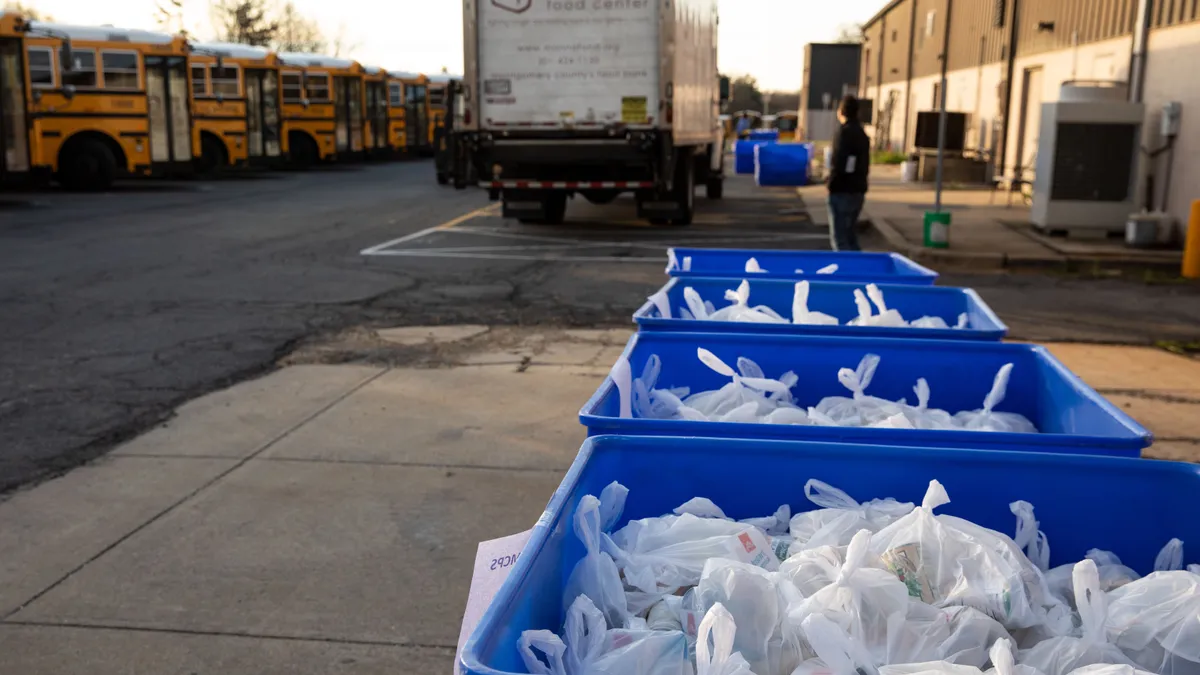Since August, schools across the U.S. have been missing breakfast and lunch items more frequently due to major supply chain disruptions that have left staff scrambling to replace items and change menus.
On a daily basis, Chesapeake Public Schools in Virginia have had to adjust school cafeteria menus since classes began this year, said Larry Wade, director of school nutrition services for the district of 45 schools and about 40,000 students. The supply chain problems have caused both delivery delays and shortages from food items that never arrive, he added.
Chesapeake students don’t have to worry if they will get a meal at school — but there’s no guarantee they will be served the exact food advertised on the menu for that day, Wade said.
However, if a time comes when there’s not enough food available because of supply chain shortages, Wade said he will considering shopping at Costco or other bulk stores to get what his schools need to feed students. Shopping at bulk grocery stores will more than likely impact the district’s food budget, because items may cost more there than from distributors who put in competitive bids to work with schools, he said.
"There’s that point of no return where you’ve shifted menus, you’ve changed menus, you’ve used what you had in stock, and if things don’t come in the back door we have to look at alternate means of getting the food we need to serve our students," Wade said.
To mitigate the effects of supply chain problems, the U.S. Department of Agriculture announced in late September it would provide $1.5 billion in assistance to schools for purchasing commodities to ensure students have access to healthy meals.
On top of that, USDA also recently waived financial penalties for any meal pattern shortcomings caused by supply chain issues. The department further permitted school districts to enter into emergency, noncompetitive procurement contracts with companies for the 2021-22 school year. This allows schools to make last-minute purchases at grocery stores, if need be.
Free meals driving food demands
While the supply chain problem has worsened in recent months for schools, the School Nutrition Association found concerns beforehand for a majority of 1,368 school meal program directors surveyed. An overwhelming 97% of school nutrition directors were already worried about pandemic supply chain disruptions, the survey discovered.
In fact, supply chain disruptions have been requiring more labor and time since the beginning of this school year from the team at Merrillville Community School Corporation in Indiana, according to food service director Angelica Claiborne. Like in the Chesapeake Public Schools, menu items are changing on the fly daily for the eight schools in her 6,000-student district, Claiborne said. The range of missing items include everything from breakfast and lunch ingredients to disposable gloves, she added.
"If the supply chain issue was not here, it would be a perfect situation."

Angelica Claiborne
Food Service Director at Merrillville Community School Corporation
Claiborne said she and her staff have been taking their work home because of extra work in managing out-of-stock items and finding replacements.
In another effect from the pandemic, USDA has continued to permit all U.S. school districts to offer free meals to all students, no matter their family’s income, through the 2021-22 school year. Both Wade and Claiborne said this increased access to free school meals has heightened the need for food and supplies in schools as well.
The waiver "is definitely helping [schools] to reach more kids and feed more kids," Claiborne said. "If the supply chain issue was not here, it would be a perfect situation."
'New way of doing business'
SNA pointed to creative solutions school districts are using to overcome supply chain disruptions. For instance, some are streamlining menus to take advantage of food on hand, ensuring all students are fed and reducing waste. Schools are also trying to improve communication with vendors to identify any missing items — before trucks arrive — and better identify what food shortages may be ahead.
Schools are even turning to local restaurants, suppliers and vendors to fill in gaps, SNA said. With a labor shortage affecting the number of truck drivers on the roads, food deliveries to schools have fallen off, too. So some districts are finding themselves transporting items dropped off by distributors from central locations, such as warehouses, to individual schools.
"Out of this will come a new way of doing business, a new approach to making things work for our children and providing healthy and nutritious meals."

Larry Wade
Director of school nutrition services for Chesapeake Public Schools
Another major concern among school meal program directors, SNA’s survey found, is staff shortages. Wade said he needs 72 more staff members in Chesapeake’s nutrition program.
Chesapeake is serving 10,000 more meals per day compared to the same time last year when there were fewer students going to class in-person, Wade said. Last school year, about 7,500 students received in-person or pickup meals per day, he said. But this year, Wade estimates nearly 17,000 meals were served daily in September.
With no end in sight to the nation’s supply chain woes, Wade remains hopeful his and other school divisions will pull through and even learn from the situation.
"Out of this will come a new way of doing business, a new approach to making things work for our children and providing healthy and nutritious meals," Wade said. "School nutrition has lasted, because it’s been resilient."























